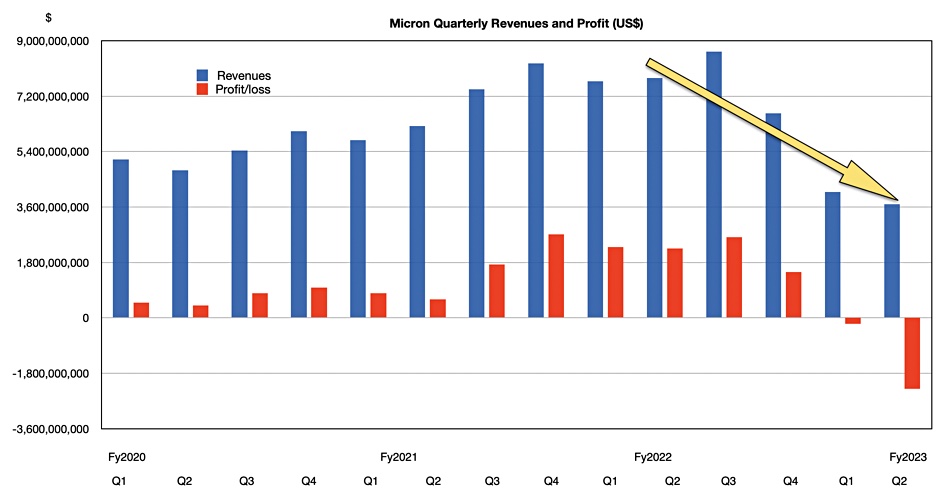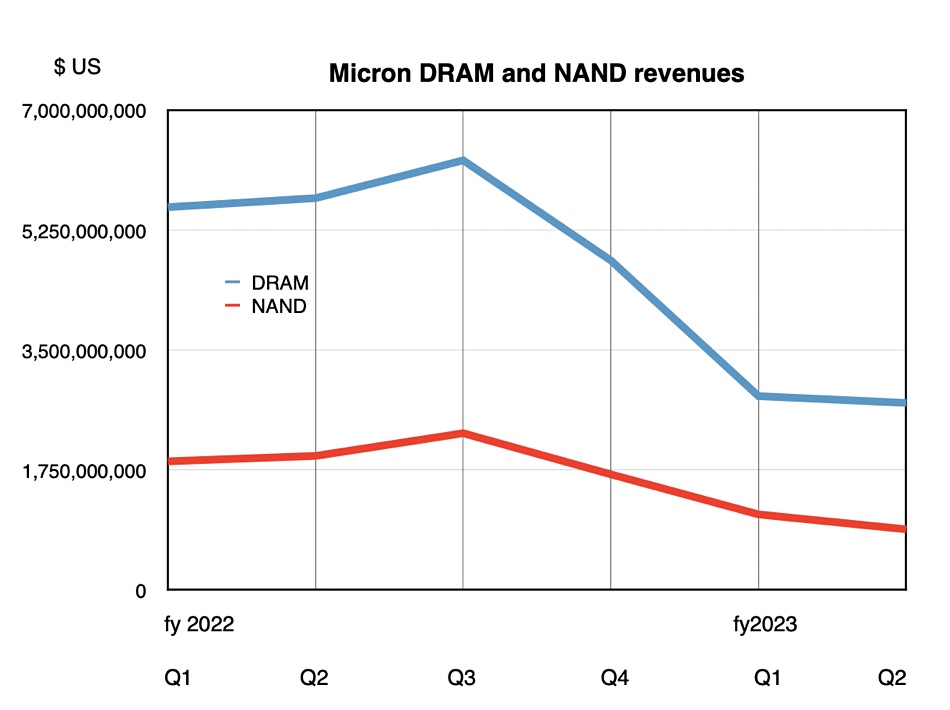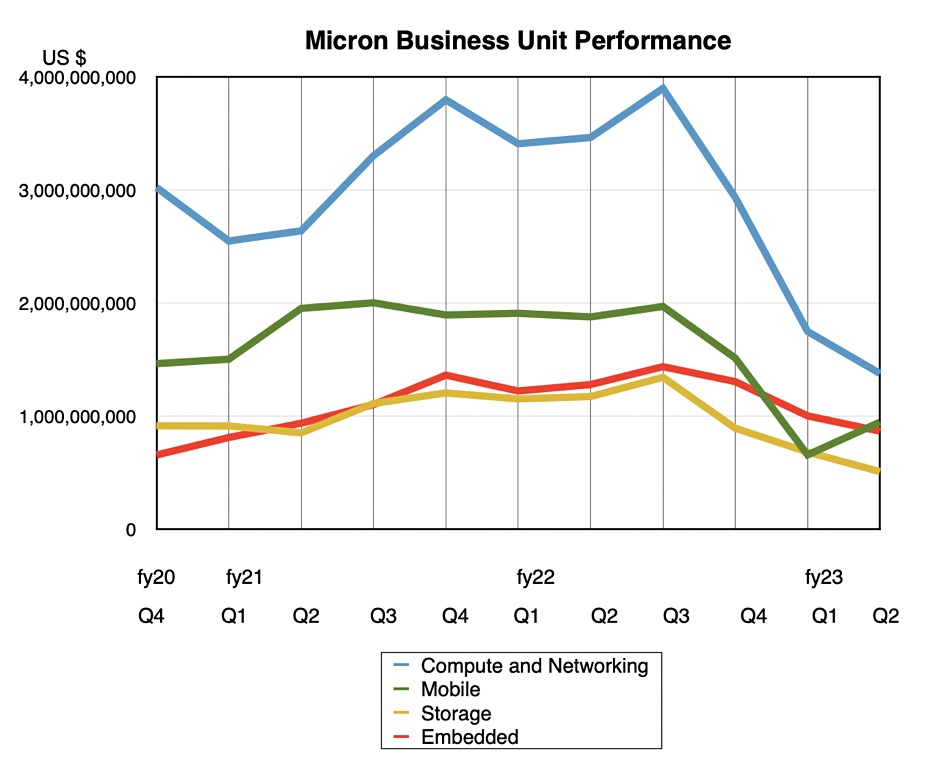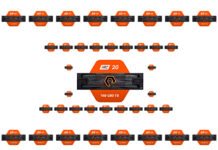Micron’s DRAM and NAND down cycle continues, with revenues falling in Q2 of its fiscal ’23 ended March 2, a massive loss posted, and a large inventory writedown recorded as the low pricing environment ran on.
Revenues plunged 52.6 percent to $3.96 billion and net loss was $2.3 billion, a reversal from last year’s $2.3 billion profit. That’s the largest loss we have recorded for Micron and our records go back to 2010. It reported a $1.03 billion loss for the entire fiscal 2012 year so this quarter’s loss is quite impressive.

Micron Technology President and CEO Sanjay Mehrotra’s said: “Micron delivered fiscal second quarter revenue within our guidance range in a challenging market environment. Customer inventories are getting better, and we expect gradual improvements to the industry’s supply-demand balance.”
His prepared remarks include this observation: “The semiconductor memory and storage industry is facing its worst downturn in the last 13 years, with an exceptionally weak pricing environment that is significantly impacting our financial performance. We have taken substantial supply reduction and austerity measures, including executing a companywide reduction in force.”

The job cuts disclosed in December 2022 were about 10 percent of the workforce but the updated plan is to reduce headcount by a total of 15 percent throughout this financial year.
Micron said it thinks the downcycle could be ending and a transition to sequential revenue growth is likely in its Q4. The company said it is confident in long term demand and also paying a quarterly dividend of $0.115/share but share buybacks are suspended.
Financial summary
- Gross margin: -31 percent
- Inventory write-down: $1.43 billion, impact of $1.34 per diluted share
- Operating cash flow: $343 million vs $943 million for prior quarter and $3.63 billion a year ago
- Free cash flow: -$1.81 billion
- Cash, marketable investments, and restricted cash: $12.12 billion
- Diluted earnings (loss) per share: -$2.12 vs $2.00 a year ago.
Micron said it hopes to return to positive quarterly free cash flow within fiscal 2024. AI could prompt growth and help that. Micron thinks large language models, or LLMs, such as ChatGPT, need significant amounts of memory and storage to operate. It said we’re in the very early stages of the widespread deployment of these AI technologies and potential exponential growth in their commercial use cases.
Technology and inventories
On the technology front 1-alpha represents most of its DRAM bit production, and it is progressing in initiating its transition to 1-beta. Micron said it was also making good progress towards the introduction of the EUV based 1-gamma node DRAM node. In NAND, 176-layer and 232-layer represented more than 90 percent of NAND bit production, with 20 percent of that QLC. The 1-beta DRAM and 232-layer NAND have reached targeted yields ahead of schedule and faster than any of its prior nodes.

In the datacenter segment, Micron reckons its revenue bottomed in the quarter. Datacenter customer inventories should reach relatively healthy levels by the end of calendar 2023. AI is a secular driver of demand growth in the data center. The product roadmap features HBM and CXL memory products. Micron is sample shipping CXL DRAM to OEM customers in the enterprise, cloud and high-performance computing (HPC) workload areas.
PC client customer inventories have improved meaningfully, and it expects increased bit demand in the second half of the fiscal year. But PC and graphics units are forecast to decline by mid-single digit percentage over calendar 2023. Smartphone units are expected to be down slightly YoY in 2023 as well but, as with PCs, Micron expects growth in bit shipments in the second half of its fiscal year.
Micron said it is the market share leader in the auto and industrial segment, which accounts for 20 percent of its revenue and which actually grew year-on-year. Micron expects continued growth in auto memory demand for the second half of calendar 2023, driven by gradually easing non-memory supply constraints and increasing memory content per vehicle.

Overall while the DRAM/NAND industry supply demand balance is expected to gradually improve, due to the high levels of inventories, industry profitability and free cash flow are likely to remain extremely challenged in the near term. Market recovery can accelerate if there is a year-to-year reduction in production, or in other words, negative DRAM and NAND industry bit supply growth in 2023. Micron is doing its bit, so to speak. Its year-on-year bit supply growth in calendar 2023 will be meaningfully negative for DRAM and it also expects to produce fewer NAND bits year-on-year in calendar 2023 too.
Cost-cutting and prices
Against this background Micron has further reduced DRAM and NAND wafer starts, which are now down by 25 percent. It is cutting heads and has lowered production output.
Micron says it has a flat bit share strategy: “While we have had to reduce price to remain competitive in the market, we have not done so in an attempt to gain share, as such share changes at customers are generally transitory.”
Micron’s third quarter guidance is for revenues of $3.7 billion plus/minus $200 million which compares to $8.6 billion in Q3 revenues a year ago, a 57 percent drop. Profitability will be extremely challenged. Maybe this will be the bottom and the quarter after that start an upturn.








